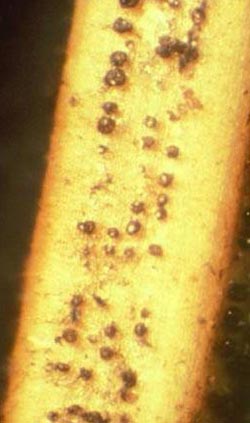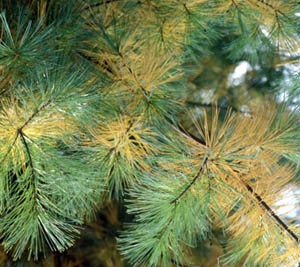Conifer Disease Help | |
|---|---|
| November 20, 2007 | |
|
Based on the number of requests for presentations on conifer diseases, it is obvious that many people need help in sorting out the differences. Conifers are usually evergreen, with bald cypress, larch, and dawn redwood the exceptions in Illinois. All the other conifers we grow, such as pine, spruce, fir, and Douglas-fir, hold their needles the year around. It is natural for evergreens to drop third-year needles at some point in the year (see white pine image), Many diseases commonly affect conifers in Illinois, including four different needle cast diseases, three needle blights, five shoot and twig blights, two stem diseases, five rusts, one wilt disease, and three root rot diseases. If you are working with evergreens on a regular basis, learn to recognize at least those diseases we see most frequently in Illinois: Needle cast: Rhizosphaera on spruce Needle blight: Brown spot and Dothistroma on pine; Cercospora on juniper Shoot/twig blight: Phomopsis on juniper; Diplodia on pine Stem disease: Cytospora canker of spruce, fir, Douglas-fir; Botryosphaeria on juniper Rusts: Gymnosporangium rusts, including cedar–apple, cedar–hawthorn, cedar–quince Wilt disease: pine wilt Root rots: Phytophthora on juniper, yew, pine; Procerum on white pine I have a few suggestions on what you can do to work toward determining the cause of your conifer problems. First, take a step back and examine the big picture. The pattern of affected plants in the landscape or planting block is important to diagnosticians. Most diseases begin in hot spots and slowly spread from those sources. It is rare to see a disease affect a line of trees at once or to appear seemingly over night. Look at similar trees in the community to see whether they also show the symptoms. If all the pines in the area are affected, environmental stress is more likely. Weather conditions generally have an equalizing effect. Next, determine the pattern on one affected plant. A tree that is yellow or off-color on one entire side suggests a stress on that side of the tree. Salt-spray-burn in the winter can be seen as a one-sided burn on evergreens. Just look along our Interstate Highways to see what I mean. On the other hand, if the entire tree declines at once, look at roots or the lower stem as potential sites of problems. You may find that the trunk has been girdled by old nylon twine left at planting, roots have grown around the base of the tree, or a weed trimmer has girdled the trunk. Tip-browning over the entire tree might indicate root rot, drought stress, flooding injury, mechanical injury, or other factors that could affect roots, resulting in discolored new growth. Excessive fertilization can also cause browning of stem and needle tips. Any root damage may be expressed as browning of new growth. Gather facts about the site, care of the trees, and especially practices or events that may have changed prior to problem expression. It is helpful to know the plant species to determine possible sensitivities. For example, Scotch pines are very susceptible to pine wilt. Find out whether chemicals have been used on the plant or on nearby plants, and determine timing in relation to symptom expression. Usually chemical injury appears soon after chemicals are applied. Was there a late frost just before tip-burn developed on your spruce? One last step is to look for signs of disease or evidence of insect activity. Disease pathogens often form structures that we call fruiting bodies. These structures are usually about the size of a pinhead and are embedded in affected tissue. They don’t rub off easily. Diseases such as Diplodia blight on pine or needle cast on spruce have such structures that clinch the diagnosis. The image shows fruiting bodies on a spruce needle infected with Rhizosphaera needle cast.  Many good Web sites offer information about conifer diseases. The Extension Web site, http://www.urbanext.uiuc.edu/focus/, describes some evergreen tree and shrub problems. Fact sheets about specific diseases can be found at http://www.ag.uiuc.edu/%7Evista/horticul.htm. Plant samples and pictures may be taken to your local extension office for diagnostic help and possibly diagnosed through the University of Illinois Extension distance digital diagnostic system, which uses specialists from throughout the state. The University of Illinois Plant Clinic (http://plantclinic.cropsci.uiuc.edu) is another option available from May to September. Early diagnosis is important. Once a positive diagnosis has been made, we can suggest changes in cultural practices, possible spray options, or other ideas to help you manage the problems found on your conifers. |
 usually in autumn, but one- and two-year-old needles are not affected. If they are, your tree may have a problem. Additionally, fall needle drop is often worse on stressed trees.
usually in autumn, but one- and two-year-old needles are not affected. If they are, your tree may have a problem. Additionally, fall needle drop is often worse on stressed trees.